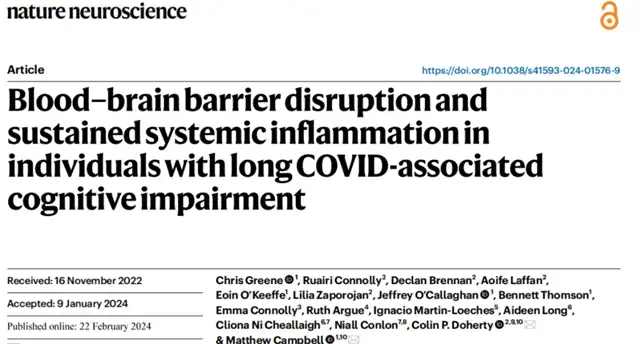Long COVID Brain Fog: Blood-Brain Barrier Damage and Persistent Inflammation
- Normal Liver Cells Found to Promote Cancer Metastasis to the Liver
- Nearly 80% Complete Remission: Breakthrough in ADC Anti-Tumor Treatment
- Vaccination Against Common Diseases May Prevent Dementia!
- New Alzheimer’s Disease (AD) Diagnosis and Staging Criteria
- Breakthrough in Alzheimer’s Disease: New Nasal Spray Halts Cognitive Decline by Targeting Toxic Protein
- Can the Tap Water at the Paris Olympics be Drunk Directly?
Long COVID Brain Fog: Blood-Brain Barrier Damage and Persistent Inflammation
- Should China be held legally responsible for the US’s $18 trillion COVID losses?
- CT Radiation Exposure Linked to Blood Cancer in Children and Adolescents
- FDA has mandated a top-level black box warning for all marketed CAR-T therapies
- Can people with high blood pressure eat peanuts?
- What is the difference between dopamine and dobutamine?
- How long can the patient live after heart stent surgery?
Long COVID Brain Fog: Blood-Brain Barrier Damage and Persistent Inflammation
New findings on COVID-19 brain fog! Scientists have discovered that infection with the novel coronavirus can lead to persistent systemic inflammation and damage to the blood-brain barrier.
The COVID-19 pandemic seems to have receded from us, but its impact has not completely disappeared.
Brain fog is a common symptom of long COVID, referring to persistent cognitive impairment following infection with the novel coronavirus. Other respiratory virus infections (including influenza, coronaviruses, etc.) have also been reported to cause neurological issues. However, the pathogenesis and long-term outcomes of neurological or psychiatric disorders following SARS-CoV-2 infection are still poorly understood.
It is speculated that the pathogenesis of COVID-19 and related neurological sequelae may be related to vascular damage, but it is not clear what impact viral infection has on the function of the blood-brain barrier.
Recently, a research team from Saint James Hospital found that SARS-CoV-2 infection disrupts the blood-brain barrier in patients, both in those with acute infection and in those with long COVID who develop brain fog.
The study suggests that persistent systemic inflammation and dysfunction of the blood-brain barrier are key features of patients with long COVID brain fog.
The research was published in Nature Neuroscience.

At the beginning of the COVID-19 pandemic, researchers collected blood samples from 76 COVID-19 patients from different hospitals.
Compared with samples from healthy controls, researchers found that levels of markers for inflammation, coagulation, and blood-brain barrier dysfunction were increased in COVID-19 patients.
Patients experiencing brain fog were typically older, and levels of blood-brain barrier dysfunction markers (serum protein S100β) were significantly elevated.
Blood-brain barrier breakdown in patients with brain fog
In this study, researchers recruited 10 COVID-19 survivors, 11 long COVID patients, and 11 long COVID patients with brain fog (some participants reported loss of smell and/or cognitive impairment) for visual analysis of the blood-brain barrier.
Dynamic contrast-enhanced MRI imaging showed a significant increase in whole-brain leakage in patients with long COVID brain fog, and regional analysis showed significantly increased blood-brain barrier permeability in the left and right temporal and frontal cortices of patients.
Changes in brain structure
To confirm whether there were changes in brain structure, researchers compared the brain structures of long COVID patients and age-matched healthy controls using the publicly available IXI dataset.
Compared with healthy controls, all individuals who had been infected with COVID-19 showed reduced volumes in the temporal and frontal lobes of the brain, and increased volumes in the lateral ventricles and occipital lobes. When comparing individuals who had been infected with COVID-19 but had recovered with those with brain fog, as blood-brain barrier permeability increased, patients with brain fog had smaller whole-brain volumes, significantly reduced white matter volumes in the brain and cerebellum, and significantly increased cerebrospinal fluid volume.
Furthermore, compared with recovered individuals, patients with brain fog had increased levels of plasma transforming growth factor-β (TGFβ), which were associated with abnormal blood-brain barrier permeability and significantly correlated with changes in brain structure, suggesting that TGFβ may play a role in neuroinflammation and brain structural changes.
At the same time, there were significant changes in the gene expression of peripheral blood mononuclear cells in long COVID patients, indicating persistent immune system activation and inflammation. Principal component analysis of brain fog patients and long COVID survivors showed clear separation, with upregulation of T-cell activation, TGFβ signaling transduction, and vascular regulation-related pathways, and downregulation of platelet activation and hemostasis-related genes. Patients with or without brain fog in long COVID showed differences in gene expression in pathways related to negative regulation of immune response and circadian rhythm, among others.
In conclusion, the study suggests that long COVID-derived brain fog is associated with blood-brain barrier breakdown and persistent systemic inflammation.
Dysfunction of the blood-brain barrier occurs only in patients with acute COVID-19 infection and related brain fog, and multiple neuroanatomical regions still show significant structural damage one year after infection.
Long COVID Brain Fog: Blood-Brain Barrier Damage and Persistent Inflammation
Reference:
Greene C, Connolly R, Brennan D, et al. Blood–brain barrier disruption and sustained systemic inflammation in individuals with long COVID-associated cognitive impairment. Nature Neuroscience, 2024: 1-12.
(source:internet, reference only)
Disclaimer of medicaltrend.org
Important Note: The information provided is for informational purposes only and should not be considered as medical advice.



